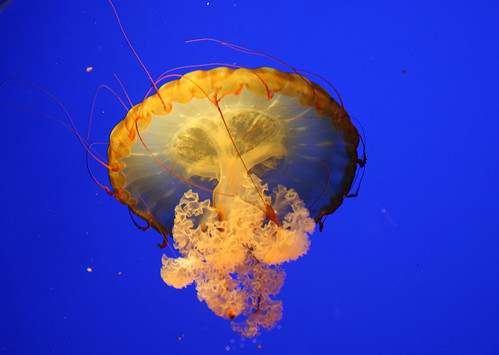Welcome to Word Buzz Wednesday, in which we round up our favorite buzzworthy words of the week. The latest: a totes adorabilis octopus; Brotox for brow’s feet; a self-healing jellyfish.
adorabilis
“‘One of the thoughts I had was making it ‘Opisthoteuthis adorabilis’ because they are just—yeah, they’re really cute,’ she says in the video by Science Friday.”
Gwynn Guilford, “This tiny octopus is so cute, scientists want to name it ‘adorabilis,’” Quartz, June 17, 2015
Looking like something out of Finding Nemo, this tiny pink octopus dwells in the deep sea and is part of the family nicknamed “flapjack” octopodes, so-called because they travel by “flapping a fringe of webbing” between their arms as they hover above the seafloor.
In case you were wondering, octopodes, not octopi, is the proper plural of octopus. The suffix -i as the plural of -us is Latin while the word octopus comes from the Greek oktopous, “eight-footed.”
Brotox
“While women still supply most of the demand for cosmetic drugs, Allergan is betting that by marketing to men, it can squeeze more growth out of well-known drugs such as Botox and create new markets with treatments like Kythera’s Kybella, for double chins. Call it the ‘Brotox’ strategy.”
Ryan Sachetta and Cynthia Koons, “Worried About Wrinkles, Guys? Allergan Bets You’ll Want ‘Brotox’,” Bloomberg, June 17, 2015
Brotox, a blend of bro and Botox, is just one in a long line of products “repackaged” for men, including broga, brogurt, murse, and meggings.
Fridgehenge
“Pranksters behind the mysterious ‘Fridgehenge’ have been revealed.”
Jon Livesey, “‘Fridgehenge’ pranksters mark summer solstice with homage to Stonehenge – made out of white goods,” The Mirror, June 22, 2015
Fridgehenge refers to several refrigerators arranged like the stones of Stonehenge.
Thousands of people descend on Stonehenge every summer solstice to celebrate the longest day of the year around the mysterious stones that might have been used in religious rites “by early Britons 4,000 years ago.”
Fridgehenge shouldn’t be confused with Manhattanhenge, the twice-yearly lining up of the sunset with Manhattan’s street grid
Holocene Extinction
“You’ve probably heard about the Holocene Extinction by now, or the catchier, media-friendly Sixth Extinction.”
Dan Seitz, “What Is the Holocene Extinction? An Explainer,” Uproxx, June 22, 2015
In this latest mass extinction (the last one occurred 66 million years ago and was the one that wiped out all non-avian dinosaurs), animals are going extinct “more than a hundred times faster than the average background rate.” Because of human activity, the number of species that should have gone extinct over 11,400 years have disappeared in just one hundred.
Holocene refers to an epoch that began 10,000 years ago and continues today. The word ultimately comes from the Greek holos, “whole.”
symmetrization
“Because jellyfish often suffer from injuries—sometimes inflicted by unsuccessful predators—symmetrization is an important method to heal themselves.”
Carrie Arnold, “The Surprising Way Jellyfish Put Themselves Back Together,” National Geographic, June 15, 2015
Symmetrization is a newly discovered phenomenon which refers to when an organism, post-injury, rearranges itself so that it’s symmetrical, like a jellyfish that has lost two of its eight legs and repositions its other legs so that they are “once again evenly spaced.”
[Photo via Flickr: “Jellyfish 1,” CC BY 2.0 by L. Church]
